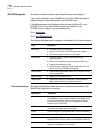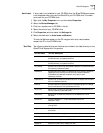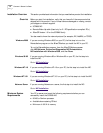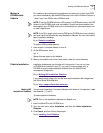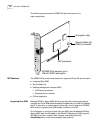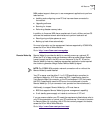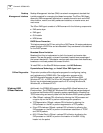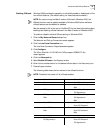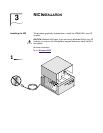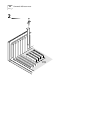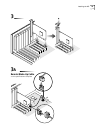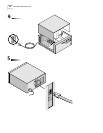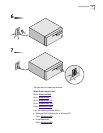
18 CHAPTER 2: 3CR990 NICS
Desktop
Management Interface
Desktop Management Interface (DMI) is a network management standard that
is widely accepted for managing Intel-based computers. The 3Com DMI Agent
allows any DMI management application to access information such as the NIC
driver location, version, and size; packets sent statistics; crc receive errors; and
much more.
The 3Com DMI Agent consists of a DMI browser with the following components:
■ DMI service layer
■ DMI agent
■ GUI installer
■ NDIS drivers
DHCP Server Prevention
This feature prevents the PC from acting like a DHCP server. All receive packets are
passed through a DHCP filter and are discarded if they are deemed to be destined
for the DHCP process.
Broadcast Storm Limitation
Broadcast throttling is implemented on both the transmit and receive data
streams. The user can specify a transmit broadcast threshold as a percentage of
the transmit bandwidth. The adapter monitors each data stream and discards any
broadcast or multicast packets that exceed this limit.
To install DMI, on the EtherCD Welcome screen, click NIC Software,
DynamicAccess Technology, and Install 3Com DMI Agent now.
Offline Diagnostics This product provides offline diagnostics programs for configuring, testing,
and troubleshooting 3CR990 NICs. The configuration program within
the DOS diagnostics program is used for a PC running Windows 2000,
Windows NT 3.51, or DOS. The 3Com NIC diagnostics program (3Com NIC
Doctor) is a windows-based program used for a PC running Windows 98,
Windows 95, or Windows NT 4.0.
Windows 2000
Offload Features
Additionally, the 3CR990 NICs support windows 2000 offload features in an
IP environment. The 3CR990 NIC Windows 2000 offload features are designed
to enhance the Windows 2000 operating system capabilities by offloading key
TCP/IP networking and security tasks from the Windows 2000 operating system:
■ IPSec Offload—reduces CPU utilization by allowing the 3XP processor and
a crypto chip on the NIC to perform data encryption operations.
■ TCP Segmentation Offload—reduces CPU utilization by allowing the
3XP processor on the NIC to perform segmentation of TCP packets
■ IP and TCP checksum Offload—reduced CPU utilization by allowing the
3XP processor on the NIC to perform the checksum calculation of TCP/IP
and UDP/IP packets
■ 802.1P Packet Priority Offload—reduces CPU utilization by allowing the
3XP processor on the NIC to perform the insertion of the 802.1Q tag
header into the packet



